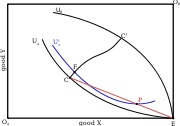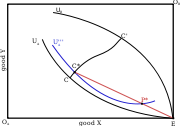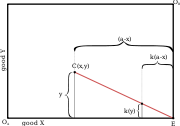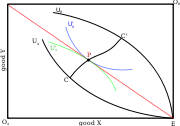
Edgeworth's limit theorem
Encyclopedia
Edgeworth's limit theorem is an economic
theorem created by Francis Ysidro Edgeworth
that examines a range of possible outcomes which may result from free market
exchange or barter
between groups of people. It shows that while the precise location of the final settlement (the ultimate division of goods) between the parties is indeterminate, there is a range of potential outcomes which shrinks as the number of traders increases.
(with quantities traded, rather than quantities possessed, on the relevant axes) to analyse trade between groups of traders of various sizes. In general he found that 'Contract without competition is indeterminate, contract with perfect competition is perfectly determinate, [and] contract with more or less perfect competition is less or more indeterminate.'
 If trade in two goods, X and Y, occurs between a single pair of trader
If trade in two goods, X and Y, occurs between a single pair of trader
s, A and B, the potential outcomes of this trade can be shown in an Edgeworth box (Figure 1). In this diagram A and B initially possess the entire stock of X and Y respectively (point E). The lines U(a) and U(b) are the indifference curve
s of A and B which run through points representing combinations of goods which give utility
equal to their initial holdings. As trade here is assumed to be non-coercive, neither of the traders will agree to a final settlement which leaves them worse off than they started off and thus U(a) and U(b) represent the outer boundaries of possible settlements. Edgeworth demonstrated that traders will ultimately reach a point on the contract curve
(between C and C') through a stylized bargaining process which is termed the recontracting process. As neither person can be made better off without the other being made worse off at points on the contract curve, once the traders agree to settle at a point on it, this is a final settlement. Exactly where the final settlement will be on the contract curve cannot be determined. It will depend on the bargaining process between the two people; the party who is able to obtain an advantage while bargaining will be able to obtain a better price for his or her goods and thus receive the higher gains from trade
.
This was Edgeworth's key finding - the result of trade between two people can be predicted within a certain range but the exact outcome is indeterminate. This finding was (erroneously) disputed by Alfred Marshall
and the discussions between the two on this point is known as the barter controversy.

 Suppose a single extra pair of identical traders is added to this initial pair. As these new traders are identical to the first pair, the same Edgeworth box can be used to analyse the exchange. To examine the new outer limits of the trade, Edgeworth considered the situation where trade occurs at the limit of trade between two people (point C or C' in Figure 2). If trade were to occur at point C one of the B's (say B(1)) would receive all the gains from trade. The one A who trades with B(1) (say A(1)) now has a mix of goods X and Y which he is able to trade with A(2). As the two A's are identical, they will agree to split their post-trade endowments equally between them, placing them at point P in Figure 2 which gives them a higher utility than they would otherwise receive (indifference curve U'(a) instead of U(a)). B(2) now has an opportunity and strong incentive to offer the A's a better price for their goods and trade with them at this price, leaving B(1) out in the cold. This process of B's competing against one another to offer the A's a better price will continue until the A's are indifferent between trading at P and trading on the contract curve (Figure 3). The same reasoning can be applied to the case where A(1) initially receives all the gains from trade, and it can be shown that the outermost limit given by U(b) will also move inwards. This is called the shrinking core of the market - as an extra pair of traders is added, the feasible range of trades shrinks.
Suppose a single extra pair of identical traders is added to this initial pair. As these new traders are identical to the first pair, the same Edgeworth box can be used to analyse the exchange. To examine the new outer limits of the trade, Edgeworth considered the situation where trade occurs at the limit of trade between two people (point C or C' in Figure 2). If trade were to occur at point C one of the B's (say B(1)) would receive all the gains from trade. The one A who trades with B(1) (say A(1)) now has a mix of goods X and Y which he is able to trade with A(2). As the two A's are identical, they will agree to split their post-trade endowments equally between them, placing them at point P in Figure 2 which gives them a higher utility than they would otherwise receive (indifference curve U'(a) instead of U(a)). B(2) now has an opportunity and strong incentive to offer the A's a better price for their goods and trade with them at this price, leaving B(1) out in the cold. This process of B's competing against one another to offer the A's a better price will continue until the A's are indifferent between trading at P and trading on the contract curve (Figure 3). The same reasoning can be applied to the case where A(1) initially receives all the gains from trade, and it can be shown that the outermost limit given by U(b) will also move inwards. This is called the shrinking core of the market - as an extra pair of traders is added, the feasible range of trades shrinks.
 If a third pair of traders is added, the core of the market shrinks further. If trade occurs at the limit where B(1) gets all the gains from trade, the point P is now two thirds of the way along the line EC. This improves the bargaining power of the A's who are able to get onto a higher indifference curve as B's compete to trade with them. The outer limit of final settlement where there are multiple pairs of traders can be generalised (Figure 4) where K = (n-1)/n.
If a third pair of traders is added, the core of the market shrinks further. If trade occurs at the limit where B(1) gets all the gains from trade, the point P is now two thirds of the way along the line EC. This improves the bargaining power of the A's who are able to get onto a higher indifference curve as B's compete to trade with them. The outer limit of final settlement where there are multiple pairs of traders can be generalised (Figure 4) where K = (n-1)/n.
 If there is a sufficient number of traders, the core of the market will shrink such that the point of final settlement is perfectly determinate (Figure 5). This point is equal to the price-taking equilibrium at which trade is assumed to take place at in models of perfect competition
If there is a sufficient number of traders, the core of the market will shrink such that the point of final settlement is perfectly determinate (Figure 5). This point is equal to the price-taking equilibrium at which trade is assumed to take place at in models of perfect competition
.
, such as those developed by John Nash
, challenge this assumption and derive stable equilibria (such as the Nash equilibrium
) in complicated bargaining situations. Further, Edgeworth's proposed recontracting process is highly stylised, involving traders obtaining information by costlessly making, breaking and re-making contracts with each other. Marshall
strongly criticised Edgeworth on this point. If the recontracting process does not explain real world behaviour then the result that the price-taking equilibrium point will be reached by competitive traders will not necessarily be true.
Economics
Economics is the social science that analyzes the production, distribution, and consumption of goods and services. The term economics comes from the Ancient Greek from + , hence "rules of the house"...
theorem created by Francis Ysidro Edgeworth
Francis Ysidro Edgeworth
Francis Ysidro Edgeworth FBA was an Irish philosopher and political economist who made significant contributions to the methods of statistics during the 1880s...
that examines a range of possible outcomes which may result from free market
Free market
A free market is a competitive market where prices are determined by supply and demand. However, the term is also commonly used for markets in which economic intervention and regulation by the state is limited to tax collection, and enforcement of private ownership and contracts...
exchange or barter
Barter
Barter is a method of exchange by which goods or services are directly exchanged for other goods or services without using a medium of exchange, such as money. It is usually bilateral, but may be multilateral, and usually exists parallel to monetary systems in most developed countries, though to a...
between groups of people. It shows that while the precise location of the final settlement (the ultimate division of goods) between the parties is indeterminate, there is a range of potential outcomes which shrinks as the number of traders increases.
Theoretical outline
Francis Ysidro Edgeworth first described what later became known as the limit theorem in his book Mathematical Psychics (1881). He used a variant of what is now known as the Edgeworth boxEdgeworth box
In economics, an Edgeworth box, named after Francis Ysidro Edgeworth, is a way of representing various distributions of resources. Edgeworth made his presentation in his book Mathematical Psychics: An Essay on the Application of Mathematics to the Moral Sciences, 1881...
(with quantities traded, rather than quantities possessed, on the relevant axes) to analyse trade between groups of traders of various sizes. In general he found that 'Contract without competition is indeterminate, contract with perfect competition is perfectly determinate, [and] contract with more or less perfect competition is less or more indeterminate.'
Trade without competition

Merchant
A merchant is a businessperson who trades in commodities that were produced by others, in order to earn a profit.Merchants can be one of two types:# A wholesale merchant operates in the chain between producer and retail merchant...
s, A and B, the potential outcomes of this trade can be shown in an Edgeworth box (Figure 1). In this diagram A and B initially possess the entire stock of X and Y respectively (point E). The lines U(a) and U(b) are the indifference curve
Indifference curve
In microeconomic theory, an indifference curve is a graph showing different bundles of goods between which a consumer is indifferent. That is, at each point on the curve, the consumer has no preference for one bundle over another. One can equivalently refer to each point on the indifference curve...
s of A and B which run through points representing combinations of goods which give utility
Utility
In economics, utility is a measure of customer satisfaction, referring to the total satisfaction received by a consumer from consuming a good or service....
equal to their initial holdings. As trade here is assumed to be non-coercive, neither of the traders will agree to a final settlement which leaves them worse off than they started off and thus U(a) and U(b) represent the outer boundaries of possible settlements. Edgeworth demonstrated that traders will ultimately reach a point on the contract curve
Contract curve
In microeconomics, the contract curve is the set of points, representing final allocations of two goods between two people, that could occur as a result of voluntary trading between those people given their initial allocations of the goods...
(between C and C') through a stylized bargaining process which is termed the recontracting process. As neither person can be made better off without the other being made worse off at points on the contract curve, once the traders agree to settle at a point on it, this is a final settlement. Exactly where the final settlement will be on the contract curve cannot be determined. It will depend on the bargaining process between the two people; the party who is able to obtain an advantage while bargaining will be able to obtain a better price for his or her goods and thus receive the higher gains from trade
Gains from trade
Gains from trade in economics refers to net benefits to agents from allowing an increase in voluntary trading with each other. In technical terms, it is the increase of consumer surplus plus producer surplus from lower tariffs or otherwise liberalizing trade...
.
This was Edgeworth's key finding - the result of trade between two people can be predicted within a certain range but the exact outcome is indeterminate. This finding was (erroneously) disputed by Alfred Marshall
Alfred Marshall
Alfred Marshall was an Englishman and one of the most influential economists of his time. His book, Principles of Economics , was the dominant economic textbook in England for many years...
and the discussions between the two on this point is known as the barter controversy.
Trade with less than perfect competition



Trade with perfect competition

Perfect competition
In economic theory, perfect competition describes markets such that no participants are large enough to have the market power to set the price of a homogeneous product. Because the conditions for perfect competition are strict, there are few if any perfectly competitive markets...
.
Generalisation
This analysis can be modified to accommodate traders who are not identical or who have motivations which aren't purely selfish as well as the situation where one group of traders is larger than the other. If the traders are heterogeneous the point P will not reflect a "split the difference" trade between the group of traders and the outer limit of trade determined by this point will be modified accordingly. If the utility of one trader(s) influences the utility of another (i.e. the latter is not selfish) then the associated limit of the contract curve will shrink inwards, ruling out the most inequitable trades. If the groups of traders are differently sized, the outer limits of the contract curve will not shrink an equal amount.Implications
There are two main implications of the limit theorem. The first is that the end result of trade between small groups of people is indeterminate and is determined by what were to Edgeworth non-economic factors. The second is that the equivalent of a price-taking equilibrium can arise from competition between very large groups of traders through the recontracting process. This equilibrium point cannot be moved by groups of traders acting in collusion to try to obtain the gains from trade for themselves as other traders will always have an incentive to leave the group out in the cold. This provides a justification for assuming price-taking behaviour in certain situations, even though explanations of how a price-taking situation can arise (such as tatonnement) are clearly implausible.Criticisms
To a large degree the indeterminacy result relies on the assumption that the results of bargaining are indeterminate or, at the very least, outside the realm of economic speculation. Modern advances in game theoryGame theory
Game theory is a mathematical method for analyzing calculated circumstances, such as in games, where a person’s success is based upon the choices of others...
, such as those developed by John Nash
John Forbes Nash
John Forbes Nash, Jr. is an American mathematician whose works in game theory, differential geometry, and partial differential equations have provided insight into the forces that govern chance and events inside complex systems in daily life...
, challenge this assumption and derive stable equilibria (such as the Nash equilibrium
Nash equilibrium
In game theory, Nash equilibrium is a solution concept of a game involving two or more players, in which each player is assumed to know the equilibrium strategies of the other players, and no player has anything to gain by changing only his own strategy unilaterally...
) in complicated bargaining situations. Further, Edgeworth's proposed recontracting process is highly stylised, involving traders obtaining information by costlessly making, breaking and re-making contracts with each other. Marshall
Alfred Marshall
Alfred Marshall was an Englishman and one of the most influential economists of his time. His book, Principles of Economics , was the dominant economic textbook in England for many years...
strongly criticised Edgeworth on this point. If the recontracting process does not explain real world behaviour then the result that the price-taking equilibrium point will be reached by competitive traders will not necessarily be true.

